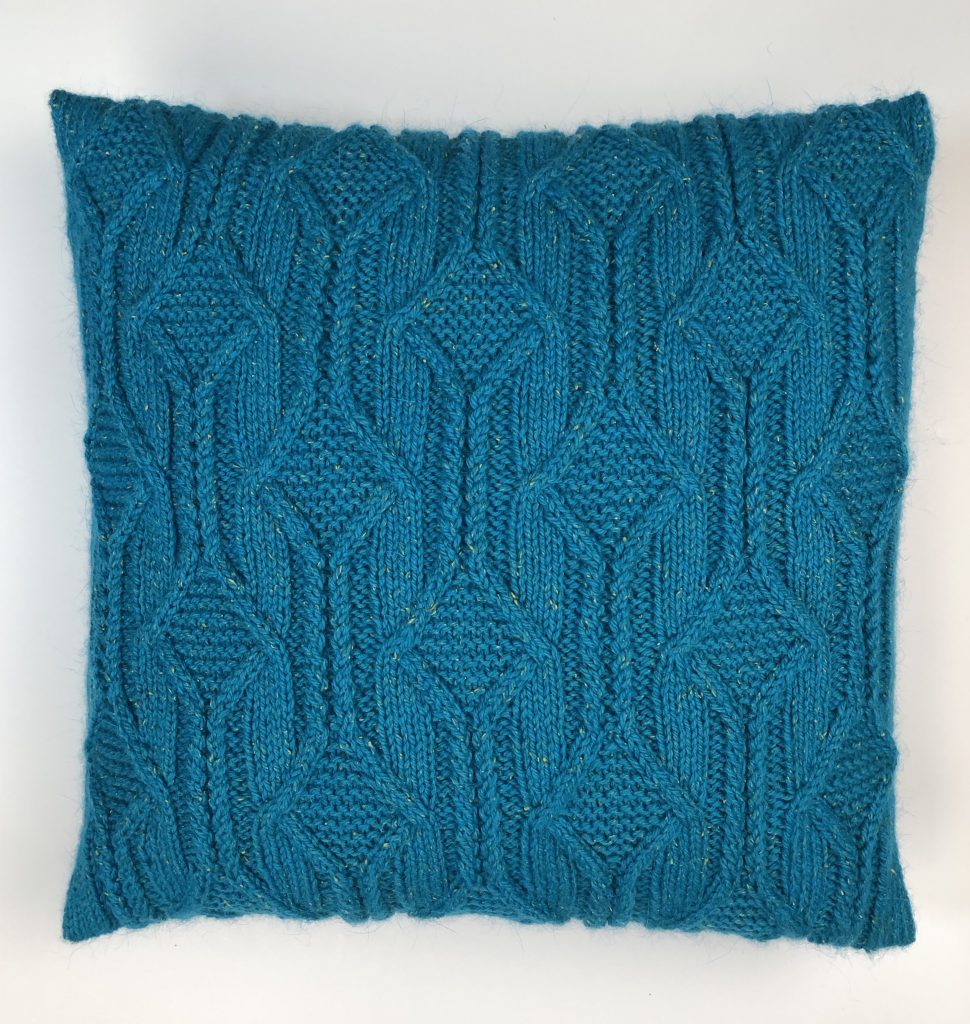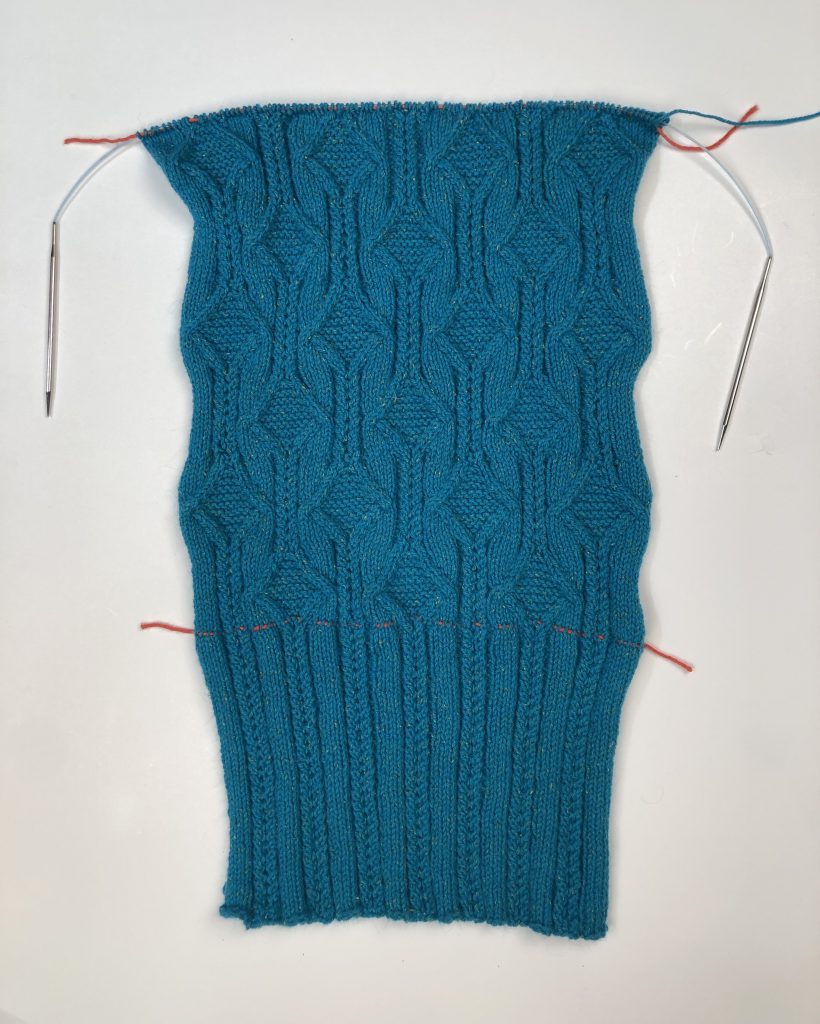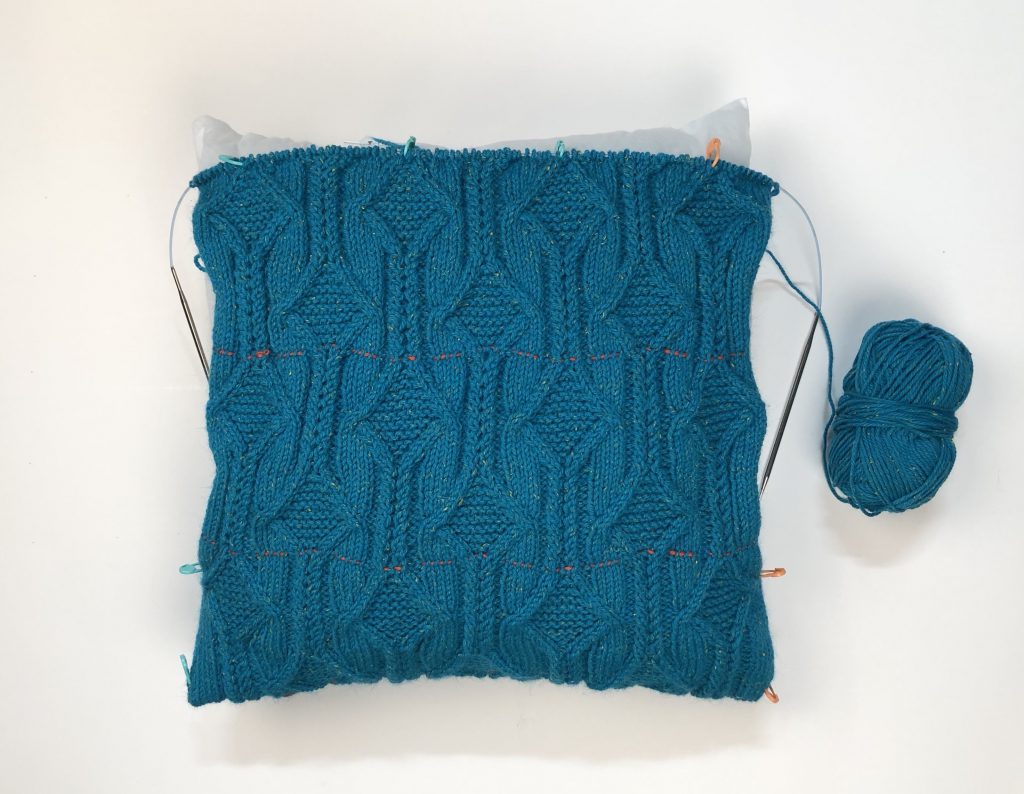I’m so excited to share Part 2 of Cable Channel with you! I’ve created an original cable pattern to grace the front of the pillow. The staggered diamonds are formed from six different types of cables for a truly unique design. I adore how the twisted ribbing from Part 1 flows into the offset diamonds with a garter stitch center.
Both written and charted instructions are provided for this pattern. While it may look complicated, take it one row at a time and you will simply fall in love with the results. For those following the charts, once again the chart is color coded for easy reading. If you are working from the written directions, I recommend highlighting the cable abbreviations within each row to eliminate confusion. The photo below shows how I colored a few rows.
As in any intricate pattern, placing markers between repeats will keep mistakes to a minimum. Both written and charted followers alike can refer to the chart to help with marker placement. The pattern repeat is found between the bold lines with the edges stitches outside of them.
While these cables are a bit more involved than the simple 2×2 cable, they all follow the basic principles of cabling. Slip a group of stitches to a cable needle and hold to either the front or the back of the work. Work the next group of stitches (may be all knit, all purl, or a combo). Lastly, work the stitches off of the cable needle as directed in knit, purl or a combo of the two. You will amaze yourself at the complicated design that emerges with just a bit more effort. Refresh your cable memory with a quick look at my Cables video.
Be extra careful on the wrong side rows. The center of the diamonds are worked in garter so it is very tempting to purl on the wrong side rows. These centers are worked in knit on the wrong side.
Work the 36-row repeat three times ending after Row 36. Knit to gauge, the pillow front measures between 13-13 1/2″ high. Due to the way nature of the top edge it is a bit hard to get an accurate measurement. Don’t forget a lifeline at the end of this section to aid in the finishing process.
Do not fret if your front is longer or shorter than mine. The pattern is designed with a fluid transition from one stitch pattern to another. It is perfectly acceptable if your front is longer and spills a bit over onto the back. Conversely, if your front is a little too short, you will center it on the pillow with the back stitch pattern showing a little more on the front. I designed the pattern to have a lot of flexibility in the fit. Any size adjustments will occur in Part 3 and everyone will be fine. Have no fear and knit on with confidence!
My finished front is slightly smaller than my pillow form (below). It stretched nicely over the form as seen in the first photo of this post.
For those keeping a close eye on yardage, here are my benchmarks on the Front for your reference:
- Joined 2nd skein on Row 11 of 1st repeat
- 2nd skein weighed 28g after one repeat
- Joined 3rd skein on Row 6 of 3rd repeat
- 3rd skein weighed 26g after completing Front
Next week’s clue brings some delightful cable buttonholes to complete the knitting. See you then!
Happy knitting,
Michelle
Part Two
Click here to download printable version
For all cable stitches, refer See Cables Video.
C1BK2 – slip next stitch onto cable needle and hold in back of work, knit next 2 stitches from left hand needle, then k1 from cable needle.
C1BK2P – slip next stitch onto cable needle and hold to back of work, k2, p1 from cable needle.
C2FK1 – slip next 2 stitches onto cable needle and hold to front of work, knit next stitch from left hand needle, k2 from cable needle.
C2FPK2 – slip next 2 stitches onto cable needle and hold to front of work, p1, k2 from cable needle.
C4B – slip next 2 stitches onto cable needle and hold in back of work, knit next 2 stitches from left hand needle, then knit 2 stitches from cable needle.
C4F – slip next 2 stitches onto cable needle and hold in front of work, knit next 2 stitches from left hand needle, then knit 2 stitches from cable needle.
cn – cable needle.
LT (Left Twist) – slip as if to knit, slip as if to knit, return both slipped stitches to left needle. Knit second stitch through the back loop, then knit both stitches together through the back loop. See Left Twist Mirror Image Video
RT (Right twist) – knit two stitches together and without taking stitches off left hand needle, reknit the first stitch and remove both stitches from left hand needle. See Right Twist Video
Section B – Pillow Front
Cable Channel – mult. of 26 + 23, 36 rows (See Chart B below)
Row 1. (RS) K7, p2, RT, p1, *LT, p2, k4, p1, C1BK2, k1, C2FK1, p1, k4, p2, RT, p1; repeat from * to last 11 sts, LT, p2, k7.
Row 2. (WS) P7, k2, p2, *k1, p2, k2, p4, k1, p2, k3, p2, k1, p4, k2, p2; repeat from * to last 12 sts, k1, p2, k2, p7.
Row 3. K7, p2, RT, p1, *LT, p2, k4, C1BK2, k3, C2FK1, k4, p2, RT, p1; repeat from * to last 11 sts, LT, p2, k7.
Row 4. P7, k2, p2, *k1, p2, k2, p6, k5, p6, k2, p2; repeat from * to last 12 sts, k1, p2, k2, p7.
Row 5. K7, p2, RT, p1, *LT, p2, k3, C1BK2, k5, C2FK1, k3, p2, RT, p1; repeat from * to last 11 sts, LT, p2, k7.
Row 6. P7, k2, p2, *k1, p2, k2, p5, k7, p5, k2, p2; repeat from * to last 12 sts, k1, p2, k2, p7.
Row 7. K7, p2, RT, p1, *LT, p2, k2, C1BK2, k7, C2FK1, k2, p2, RT, p1; repeat from * to last 11 sts, LT, p2, k7.
Row 8. P7, k2, p2, *k1, p2, k2, p4, k9, p4, k2, p2; repeat from to last 12 sts, k1, p2, k2, p7.
Row 9. K7, p2, RT, p1, *LT, p2, C4F, k9, C4B, p2, RT, p1; repeat from * to last 11 sts, LT, p2, k7.
Row 10. P7, k2, p2, *k1, p2, k2, p4, k9, p4, k2, p2; repeat from * to last 12 sts, k1, p2, k2, p7.
Row 11. K7, p2, RT, p1, *LT, p2, k2, C2FK1, k7, C1BK2, k2, p2, RT, p1; repeat from * to last 11 sts, LT, p2, k7.
Row 12. P7, k2, p2, *k1, p2, k2, p5, k7, p5, k2, p2; repeat from * to last 12 sts, k1, p2, k2, p7.
Row 13. K7, p2, RT, p1, *LT, p2, k3, C2FK1, k5, C1BK2, k3, p2, RT, p1; repeat from * to last 11 sts, LT, p2, k7.
Row 14. P7, k2, p2, *k1, p2, k2, p6, k5, p6, k2, p2; repeat from * to last 12 sts, k1, p2, k2, p7.
Row 15. K7, p2, RT, p1, *LT, p2, k4, C2FPK2, k3, C1BK2P, k4, p2, RT, p1; repeat from * to last 11 sts, LT, p2, k7.
Row 16. P7, k2, p2, *k1, p2, k2, p4, k1, p2, k3, p2, k1, p4, k2, p2; repeat from * to last 12 sts, k1, p2, k2, p7.
Row 17. K7, p2, RT, p1, *LT, p2, k4, p1, C2FPK2, k1, C1BK2P, p1, k4, p2, RT, p1; repeat from * to last 11 sts, LT, P2, k7.
Row 18. P7, k2, p2, *k1, p2, k2, p4, k2, p2, k1, p2, k2, p4, k2, p2; repeat from * to last 12 sts, k1, p2, k2, p7.
Row 19. K7, p1, C1BK2, k1, *C2FK1, p1, k4, p2, RT, p1, LT, p2, k4, p1, C1BK2, k1; repeat from * to last 11 sts, C2FK1, p1, k7.
Row 20. P7, k1, p2, k1, *k2, p2, k1, p4, k2, p2, k1, p2, k2, p4, k1, p2, k1; repeat from * to last 12 sts, k2, p2, k1, p7.
Row 21. K7, C1BK2, k2, *k1, C2FK1, k4, p2, RT, p1, LT, p2, k4, C1BK2, k2; repeat from * to last 11 sts, k1, C2FK1, k7.
Row 22. P9, k2, *k3, p6, k2, p2, k1, p2, k2, p6, k2; repeat from * to last 12 sts, k3, p9.
Row 23. K6, C1BK2, k3, *k2, C2FK1, k3, p2, RT, p1, LT, p2, k3, C1BK2, k3; repeat from * to last 11 sts, k2, C2FK1, k6.
Row 24. P8, k3, *k4, p5, k2, p2, k1, p2, k2, p5, k3; repeat from * to last 12 sts, k4, p8.
Row 25. K5, C1BK2, k4, *k3, C2FK1, k2, p2, RT, p1, LT, p2, k2, C1BK2, k4; repeat from * to last 11 sts, k3, C2FK1, k5.
Row 26. P7, k4, *k5, p4, k2, p2, k1, p2, k2, p4, k4; repeat from * to last 12 sts, k5, p7.
Row 27. K3, C4F, k5, *k4, C4B, p2, RT, p1, LT, p2, C4F, k5; rep from * to last 11 sts, k4, C4B, k3.
Row 28. P7, k4, *k5, p4, k2, p2, k1, p2, k2, p4, k4; repeat from * to last 12 sts, k5, p7.
Row 29. K5, C2FK1, k4, *k3, C1BK2, k2, p2, RT, p1, LT, p2, k2, C2FK1, k4; repeat from * to last 11 sts, k3, C1BK2, k5.
Row 30. P8, k3, *k4, p5, k2, p2, k1, p2, k2, p5, k3; repeat from * to last 12 sts, k4, p8.
Row 31. K6, C2FK1, k3, *k2, C1BK2, k3, p2, RT, p1, LT, p2, k3, C2FK1, k3; repeat from * to last 11 sts, k2, C1BK2, k6.
Row 32. P9, k2, *k3, p6, k2, p2, k1, p2, k2, p6, k2; repeat from * to last 12 sts, k3, p9.
Row 33. K7, C2FPK2, k2, *k1, C1BK2P, k4, p2, RT, p1, LT, p2, k4, C2FPK2, k2; repeat from * to last 11 sts, k1, C1BK2P, k7.
Row 34. P7, k1, p2, k1, *k2, p2, k1, p4, k2, p2, k1, p2, k2, p4, k1, p2, k1; repeat from * to last 12 sts, k2, p2, k1, p7.
Row 35. K7, p1, C2FPK2, k1, *C1BK2P, p1, k4, p2, RT, p1, LT, p2, k4, p1, C2FPK2, k1; repeat from * to last 11 sts, C1BK2P, p1, k7.
Row 36. P7, k2, p2, *k1, p2, k2, p4, k2, p2, k1, p2, k2, p4, k2, p2; repeat from * to last 12 sts, k1, p2, k2, p7.
Work above 36 rows three times ending after Row 36.
(3rd skein weighs 26g, Front = 13-13 ½” tall)
Chart B
Cable Channel – mult. of 26 + 23, 36 rows






